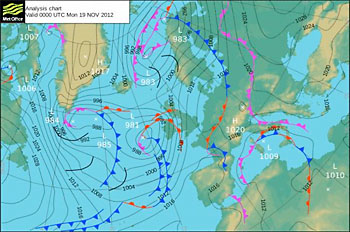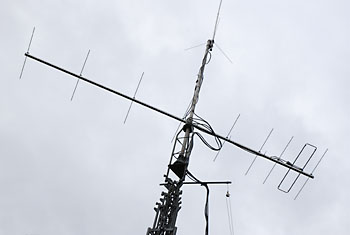VHF/UHF Propagation
While HF propagation pundits are concerned with the ionosphere, VHF/UHF enthusiasts generally have their sights set a little lower – on the troposphere.
Under normal or flat conditions most VHF and UHF communications are generally thought to be line of sight – the higher your antennas the better.
Fortunately, reality is actually a little different thanks to the way VHF and UHF signals can be refracted. This process is the same as that seen with light. Put a pencil in a glass of water and it seems to bend. Look along a hot asphalt road in the middle of summer and it looks like water in the distance. Both of these phenomena are due to the way that the velocity of light waves changes in different media.
Another way of looking at it is that different materials have different refractive indices. The same process applies to radio waves, which are electromagnetic and therefore part of the same “family” as light waves.
If our radio wave travels from a medium with one refractive index to another bending or refraction will occur. The amount of bending will depend on the differences in the two refractive indices.
Our lower atmosphere isn’t a static, single temperature environment. It is a swirling mass of gases, all at different pressures and different temperatures. There is also varying amounts of water vapour in the atmosphere as well.
As Steve Nichols G0KYA points out in his book “Radio Propagation Explained”, the dielectric constant of air is usually taken to be one, but in reality it changes very slightly. The average value is about 1.00030, but it can vary between 1.00027 and 1.00035.
The area of highest refractive index is near the earth. This causes radio waves to bend towards the area of higher refractive index and helps the signal to follow the earth’s curvature.
The net effect is that VHF and UHF radio signals generally travel around one third further than our strict line of sight calculations suggest they should.
But it gets better!
Tropospheric enhancements
Under certain conditions the refractive index along the path of our signals can increase. If this rate is high enough signals that would otherwise not follow the curvature of the earth and be lost into space are returned to earth at much greater distances than you would expect.
They can even be trapped in an elevated duct where they can travel for hundreds of kilometres without being audible on the ground below – a similar effect to having a skip or dead zone on HF.
While these effects are less obvious on the lower bands in the VHF spectrum, they can be very pronounced at 144 (2m) and 430MHz (70cm).
So how do we predict these and what should we be looking for? As the effects occur in the troposphere it should come as no surprise that it is the weather that affects propagation in this region.
By studying weather maps and the forecast you should be able to predict when good conditions may occur, although there are always surprises.
One of the main things to look for is a temperature or humidity inversion. Normally the temperature in the troposphere decreases with height. But under certain conditions an inversion can occur with a corresponding sharp change in the refractive index.
Look for a high pressure area over the UK or our near European neighbours. The Met Office has a useful chart at: http://www.metoffice.gov.uk/weather/uk/surface_pressure.html
This is useful as it indicates what is “high” and what is “low”. You might also want to look at http://www.meteorologica.info/Euroisobars.htm
Better conditions can occur when a high pressure area is present and particularly in the summer when temperatures are higher and there are higher levels of humidity.
High pressure areas are usually quite stable and good conditions can last for a few days. Oddly, the best conditions can also occur as the pressure starts to fall from a high. So look for high pressure regions in or around Europe and UK and a falling barometer.
You can also get a temperature inversion with the approach of a cold front. This occurs as warmer air rises over the colder air beneath creating the inversion. This is normally associated with fast-moving fronts and any lift conditions may be over quite quickly.
Other inversions in the summer can occur near sunrise as air at higher altitudes is heated first. Fog and mist in the mornings can also be signs of temperature inversions.
Unfortunately, not all high pressure systems bring good conditions or “lifts”. It is up to you to monitor other indicators such as beacon and repeater reception.
You can also get enhanced propagation across the sea. Temperature inversions occur frequently along coastal areas bordering large bodies of water. This is the result of the movement of cool, humid air shortly after sunset when the ground air cools more quickly than the upper air layers. The same action may take place in the morning when the rising sun warms the upper layers.
This area can be very close to the water, which means that stations near the water’s edge at sea level get good conditions while those on the top of hills don’t.
There are other propagation modes available to VHF operators including aurora and meteor scatter. Microwave specialists can also include troposcatter and rain scatter in their armoury.
Summer Sporadic-E
The period May to mid August is best for Sporadic E (Es) which can affect signals on all bands from 14-144MHz, although it is most commonly noticed on 28MHz and 50MHz. Sporadic E openings on 2m are rarer, but do occur. For example, most summers there are one or two good openings to Spain.
You can watch for these using a portable FM radio and look for broadcast stations around 100MHz. If you are very lucky you may hear foreign language broadcasts. This is a sign that there could be an opening on 2m as well.
But what is Sporadic-E and how can we predict it?
We know what Sporadic E is, but its exact causes are still up for debate. It is an unusual form of radio propagation where signals are refracted or bounced off fast-moving “clouds” of unusually ionised atmospheric gas in the lower E region (located at altitudes of approx. 90 to 160 km).
Short skip Es occurs when patches form in the E layer of the ionosphere. This layer normally refracts shortwave and medium wave signals, but is transparent to VHF radiation. The ionisation patches drift westwards at speeds of a few hundred km per hour.
Es events usually begin mid morning, and there is a peak in the afternoon with another peak in the evening. Es propagation is usually gone by local midnight.
The cause of Es ionisation is not precisely known. Some people have tried to connect it with thunderstorms, but there are plenty of incidences of Es where no thunderstorms were in the area.
The best theory at the moment is that it is caused by wind shear in the upper atmosphere. You can get very fast-moving winds moving in different directions. Now, inject some ions into these winds and they will be forced up or down as they interact with the earth’s magnetic field.
You can imagine a situation where some ions are forced upwards and some (in winds moving in the other direction) are forced downwards. The net result is a patch or cloud of ionisation.
These can be relatively long-lived, or come and go quite quickly. What we do know is that they move quite quickly and the propagation mode is characterised by very strong signals, rapid QSB and signals that appear and disappear from areas as the clouds move. The propagation range for Es single-hop is typically 1,000 to 2,000 km, but with multi-hop, the distances can be increased.
Now you are probably wondering where these ions come from in the first place. One theory is that they are heavy metallic ions from meteor debris.
Jim Bacon G3YLA, who is a professional meteorologist, has looked very closely at Sporadic E and has also managed to link it with weather patterns and high-level winds moving across the mountainous areas of Europe, including the Alps, the Harz mountains and the Pyrenees. He thinks that these winds over the mountains create gravity waves that move upwards, helping to compress the ionisation.
There is still room for research on Es, but for the new radio ham how do you make the most of Sporadic E?
Firstly, keep an eye on 28MHz and 50MHz. These will be the first bands to show the effects of Es. If you are away from the radio also check out www.dxmaps.com which has real-time maps of Es and other activity.
This isn’t a complete guide to VHF/UHF propagation, but it at least gives you a flavour of two modes to look out for.
Other pages in this section – Operating your new station:













